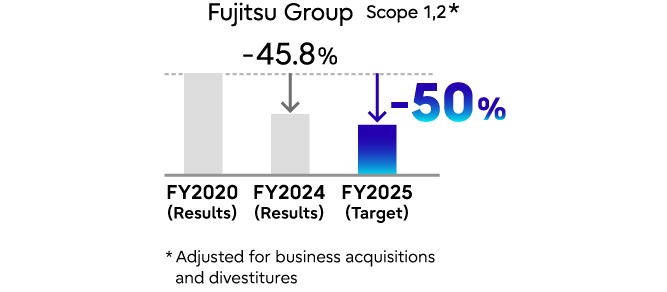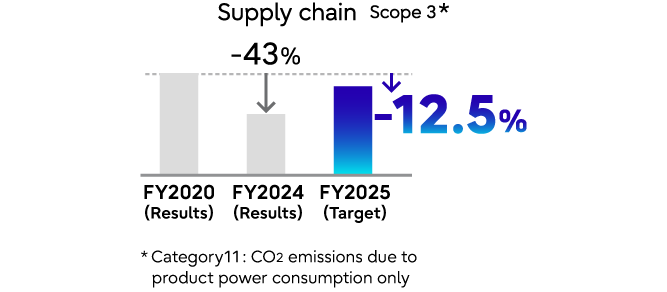Non-Financial Indicators
Approach
To contribute sustainably to the Fujitsu Purpose in the long term, it is essential to foster trusted relationships with all stakeholders. The Fujitsu Group has integrated non-financial indicators into its core business activities, promoting their achievement alongside financial targets.
To measure and verify our positive impact on customers and society, and to strengthen the Foundation for Achieving Sustainable Development, we set non-financial targets in the Medium-Term Management Plan announced in FY2023. These targets include key performance indicators (KPIs) such as: Customer Net Promoter Score (NPS®)(*1), Employee Engagement (EE), Diversity Leadership (ratio of women in leadership roles), Productivity Index, and Greenhouse Gas (GHG) Emissions Reduction Rate. We are continuously monitoring the progress of these KPIs.
*1: Net Promoter, Net Promoter Score, and NPS are trademarks of NICE Satmetrix, Inc., Bain & Company, Inc. and Fred Reichheld.
Net Promoter Score (SM) (NPS®)
Customer Net Promoter ScoreSM (NPS®) (Customer NPS) is a metric used to objectively gauge the extent to which trusted relationships with customers helps create customer loyalty. Unlike customer satisfaction, which indicates the degree of satisfaction or dissatisfaction with a purchased product or service, customer loyalty is characterized by the ability to determine the degree of customer attachment and the likelihood of repeat purchases. The Fujitsu Group employs customer NPS as one of its non-financial indicators with the aim of realizing customer-centric management. By listening to our customers' views via NPS and offering services that appropriately suit their requirements, or by making proposals that anticipate their future needs, the value of the customer experience will be enhanced and our customer NPS will rise further. We believe that creating such a positive cycle will result in a boost to the corporate value of the Fujitsu Group.
As a structure to achieve this objective, at the working level we have appointed customer experience leaders in each region to take the lead in a timely manner in relation to improvement activities. Action plans and awareness of issues developed through discussions between CX leaders and frontline employees are shared with management, ensuring that customer issues are addressed at the frontline level and treated as management issues. This creates a system with a ‘feedback loop’ to propose continuous improvement, examine areas for investment, and verify the effectiveness of measures already taken.

Against this backdrop, the NPS for FY2024 saw a slight decrease of 2.1 points year-on-year. Notwithstanding, the evaluation from existing customers has steadily increased by 5.6 points compared to the FY2022 target, so this latest result could be explained by the fact that there were not many evaluations from customers newly surveyed after expanding their business. Fujitsu continues to be highly rated, including by existing customers, as an IT solutions vendor with comprehensive capabilities for technology and quality in particular. This is seen as a result of the technological expertise the company has accumulated over many years and its sincere commitment to addressing the problems customers are facing.
Meanwhile, when it comes to responding to the rapid changes in the social and economic landscape in recent years, we recognize that our consulting capabilities in regard to our clients' management and business challenges, our ability to propose innovative and cutting-edge transformation, and our ability to execute with agility are areas that need to be improved on in the future.
We will respond to these challenges by continuing to build on the reskilling programs commenced Group-wide in FY2024. We will also continue to gather DX business model validations as a way of enhancing the company’s ability to comprehensively support customer business growth. We will focus in particular on strengthening our industry knowledge and business consulting skills, expediting the acquisition of state-of-the-art technologies, and developing human resources to accelerate customer transformation. In FY2025, the final year of our Medium-Term Management Plan, we will continue to enhance the strengths that have received praise over the past few years, at the same time focusing on improving areas that require attention in an endeavor to boost our NPS score by 20 points against a baseline of FY2022. We will achieve sustainable growth by providing value that exceeds customer expectations and building stronger trust relationships.
Employee Engagement
The Fujitsu Group's greatest management resource is its employees, who are the source of the value provided to customers. We believe that highly engaged employees are better able to provide high-quality services to our customers, that positive customer feedback increases an employee’s responsiveness to their work, and that improving the engagement of each employee therefore leads to the growth of both the individual and the Fujitsu Group. Based on this belief, we established Employee Engagement as a non-financial indicator to measure the sustainable growth of the Fujitsu Group. At Fujitsu, we define Employee Engagement as an indicator that shows the degree of employees’ motivation and attachment to work and their willingness to contribute independently in empathy with the company’s direction and purpose.” Employee Engagement can also be considered an indicator that illustrates the Fujitsu Group has the necessary human resources and other capabilities, including organizational culture, to gain the trust of customers as a DX partner. We have set a target of 75 by benchmarking against global companies. While this is an ambitious target for the Fujitsu Group, we are nonetheless striving to achieve this goal with the aim of being on par with other global enterprises.
Fujitsu has implemented a framework comprising a Center of Expertise (CoE), a specialist team dedicated to creating highly engaged organizations, and Human Resource Business Partners (HRBP), a team of strategic HR partners who work with leaders at the highest level in organizations in Japan and in our overseas regions to boost engagement. As a specific initiative, we have introduced measures to broaden employees' workstyle options, after clarifying their individual purpose. As part of this initiative, we are conducting a semiannual, global survey to measure employee engagement, the objective being to gauge in a timely manner changes in organizational culture, employee workstyles, opinions, and awareness, and to swiftly reflect the outcomes back to management. The survey includes questions about the employee’s sense of fulfillment in working for Fujitsu Group, the connection between the Fujitsu Purpose and the employee’s own work, and the degree to which employees are able to demonstrate their own strengths. Survey findings are compiled on a manager-by-manager basis and are used to bolster support for management improvement by presenting each manager with the most appropriate Recommended Actions. The HR department is working with relevant departments to introduce improvements to resolve issues identified in the survey in relation to the management foundation.
Past surveys have clearly shown that senior and middle management in each organization must be the driving force in action-taking together with their team members to boost engagement, and that strong relationships built on trust between managers and employees are vital. Meanwhile, there are also issues with the quality and quantity of communication, including a one-sided approach to everyday communication of information.
Going forward, we plan to establish a data-driven cycle to improve organizational performance and individual well-being, leveraging the valuable insights gained from analyzing engagement data. Specifically, we will go beyond using surveys to simply assess the current situation, instead analyzing, visualizing, and organizing the elements necessary for improving organizational performance and individual well-being. This will give us a deeper understanding of the state of the organization and its individuals. Additionally, we will implement AI-driven tools on a trial basis with a view to visualizing problems and identifying and addressing organizational challenges promptly and appropriately. We will also work to enhance management quality by having all management, including the executive team, demonstrate leadership by reviving two-way, cross-hierarchy communication. Thus, by taking various approaches to probing the root cause of factors influencing engagement and employing concrete measures like these, we aim to improve employee engagement, achieve sustainable growth, and contribute to society.




Diversity in Leadership (Ratio of women in leadership roles)
The Fujitsu Group aims to build a corporate culture driven by diversity and inclusion, based on the Fujitsu Way. The core vision guiding this is to “Build an inclusive and equitable culture where everyone belongs and can be completely themselves.”
Today's world is shaped by diverse values and increasingly complex social issues. Decision-making and collaboration by a diversity of leaders with different perspectives, experiences, and styles is therefore vital to Fujitsu remaining a globally preferred company that innovates and engages in sustainable value creation.
Recognizing this, Fujitsu ranks the ratio of female executives as one of its non-financial indicators. This is not just a target, but a symbolic and practical indicator aimed at enhancing diversity among the organization's decision-makers to foster a corporate culture where diverse talents are embraced and activated.
Aiming for a 30% ratio of female executives by 2030, we have adopted a multi-layered approach including workshops to promote career ownership, training programs to encourage attitudinal change in management, opportunities to shadow executives, and enhancements to inform the company’s mentoring system. We are also continuing to focus on creating an environment where everyone can work flexibly according to their stage of life, including through initiatives such as “Work Life Shift 2.0” and enhanced measures to support work-life balance.
Fujitsu views its efforts to increase the ratio of female executives as part of a broader organizational transformation, and will use the initiatives to strengthen the company's basis for enhancing both innovation and the quality of decision-making.

Per capita productivity
Up until FY2022, the Fujitsu Group was using DX Promotion Indices to measure the level of DX maturity(*2), implementing a whole spectrum of measures to promote DX and lay the groundwork for further change based on its corporate strategies. In FY2023, in order to move into the next transformation phase, the company established a new ‘productivity indicator’ for operating income per capita (which is an indicator for measuring the productivity of business activities), setting the target for the end of FY2025 at +40% against a baseline of FY2022. Throughout FY2024, we have been further promoting business model transformation centered on Fujitsu Uvance, improving productivity the more we leverage AI and digital technologies in our daily operations. Causal analysis shows that AI and digital technologies help improve work efficiency, which we count among the ways DX contributes to business transformation, boosts competitiveness, and is a driver for generating greater corporate value.
Because becoming a true DX company means utilizing data, AI and digital technologies to streamline business processes, and basing more sophisticated IT investments on those processes, the Fujitsu Group will continue to push ahead with productivity improvements, partnering and engaging with a range of initiatives rather than adhering to traditional or established approaches.
*2: Maturity level metrics tool for assessing digital business transformation on a six-point scale of 0 to 5. Consists of seven “Indicators related to DX promotion by corporate management, and the framework therefore”, and two “Indicators related to the development of platform IT systems for enabling DX.”

Reduction of GHG Emissions
The Paris Agreement (COP21), adopted in December 2015, set out a long-term, shared worldwide goal of limiting the average global temperature increase to considerably less than 2℃ and preferably 1.5℃ over pre-Industrial Revolution temperatures, as well as the goal of carbon neutrality (net zero emissions) by the second half of this century. Subsequently, following a review of climate change impacts (loss, damage, etc.) based on the latest scientific knowledge, it was declared at the COP26 Glasgow Agreement that the preferred 1.5℃ target would now become the actual target and that the world must aim to achieve net zero by mid-century (around 2050). These rapid changes led the Fujitsu Group to announce a target of net zero for GHG emissions in its supply chain by FY2040, with an interim target of net zero for GHG emissions in Fujitsu’s own business areas by FY2030. To help achieve these objectives, we released the Environmental Action Plan (Stage XI). This plan runs up to FY2025, a milestone on the path to the targets, and will give shape to our specific initiatives as we work toward the realization of carbon neutrality.


Looking ahead to 2030, Fujitsu’s materiality identifies two categories of key issues that must be addressed in order to achieve sustainable growth in the medium- to long-term: “Essential contribution” and “Foundation for achieving sustainable development.” In the area of “Essential contribution,” Fujitsu commits to leverage the development of primarily Fujitsu Uvance business to provide customers and society with value that contributes to “Solving global environmental issues,” “Developing a digital society,” and “Improving people's well-being”. With regard to “Solving global environmental issues,” we have identified “Climate change (Carbon neutrality),” “Resource circulation (Circular economy),” and “Living in harmony with nature (Conservation of biodiversity)” as key challenges. Having established indicators to specifically contribute to mitigating climate change and achieving a carbon-neutral society, we are approaching GHG emissions as a non-financial indicator.


